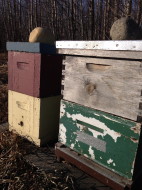The current believe in beekeeping and normally taught in bee classes here in Alaska is that bees will winter better on stores made up of sugar syrup fed to them, after taking honey stores late summer. Honey stores are considered inferior as winter stores because it is taught that honey has a lot of ash (mineral particulates) that bees must evacuate during long winters. Sometimes there is no opportunity for them to have a cleansing flight until March and may not be able to hold their feces for long enough. If a strain is to survive Alaska it must have the ability to hold their guts for long periods of time, and do it clean, with minimal soiling inside and outside the hive. It is thought that stores derived from sugar syrup is easier on the bees because it has no ash for them to have to evacuate in the winter, and that this will not contribute to a dysentery condition. A dysentery condition is easy to observe from the outside of a hive by a really thick coating of feces around the entrance and on the hive radiating from the entrance. When you enter the hive the feces is also coating the tops and sides of the frames. But really you can call it by the conditions before entering the hive by the feces at the entrance itself. This hive seems to defy that logic by wintering on honey, not sugar syrup, and keeping itself clean of dysentery. Despite the fact it is wintering on stores currently considered bad by those saying that sugar syrup is best because it is cleaner to winter on, this colony is clean, and quite, except for the constant hum from inside. All my live colonies show no ill affects of wintering on honey instead of sugar syrup either, showing little to no staining at the entrance, all seems good so far.
am hoping the picture will come through so you can see how clean the hive looks so far from the outside, very clean. The entrance that is being used is the front seam between the two deep hive bodies, the bees can easily use this entrance. I put my iPhones recorder mic up to their seam entrance to hear the bees inside, the iPhones recorder can hear better than I can. I wanted to hear them with as little disturbance as possible, I tried to be quite and did not knock on the hive as is usually how beekeepers do it. If a hive is alive during the winter they will always have a low hum in the hive while they shiver and buzz their wing muscles to keep warm. So they are always a humming, no need for knocking on the hive and riling them up. The iPhone mic picked up the hum easy as I listened to the recording. It was good to hear all the buzzing, the recording picked up the hum lots better than my ears could have, but I also put my bare ear up to the entrance and could hear the faint hum just a lower volume compared to the recording. So far this hive is fitting the example of brother Adam’s description of good wintering traits for a hive that winters in the north with long winters, In his book “Breeding the Honeybee” Sub-Title “hardiness and Ability to winter”.

Hi Keith,
I have just finished having a discussion on the HiTunnel group down here in Homer about overwintering. I would like to understand what you are doing so I can prepare to duplicate it as closely as possible, here on Diamond Ridge above Homer. Still in shock over loosing 5 hives years back. I want to have the best setup possible before I attempt it again.
I Hope you and yours are well
God Bless